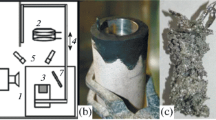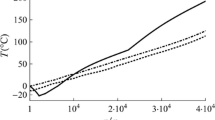Abstract
Hypotheses about the mechanisms governing fragmentation of superheated liquid metal droplets falling into cold water are analyzed. It is shown that a physical model based on the cavitation–acoustic mechanism governing fine fragmentation of melt under steam explosion conditions is likely the most suitable one for consistently describing the fragmentation of both low-melting and refractory metals. For checking this conjecture, special experiments for studying the processes triggered when cold (20°С) water comes into contact with a heated surface and for measuring the pressure impulses (arising both in coolant and in the hot body) accompanying the coolant flashing were carried out using liquid metal (tin and steel) droplets and superheated solid steel bodies. The working substance temperatures were varied in the range from 200 to 1600°С. The results obtained from the performed experiments are not in contradiction with the melt fine fragmentation process represented by the cavitation–acoustic model. It is shown that the acoustic waves generated during explosive growth of bubbles on a hot surface propagate in the solid body and are alternating in nature. Their intensity (including that at negative pressure values) differs only slightly in the modulus from the pressure impulses measured in the coolant and is sufficient for finely fragmenting the droplets. It is experimentally found—with the use of a conductance measuring technique—that the transition from the coolant film to bubble boiling mode is preceded by a short-term (lasting a few milliseconds) process involving intense interaction of waves at the steam–liquid boundary with the heated surface. The signal from the conductance measuring transducer was subjected to a wavelet analysis for different values of the heated surface temperature. The study results testify that high-frequency (several tens of kilohertz) pulsations of electric current are generated in the preburnout region with their characteristics varying (toward increasing the amplitude and intensity) with time as the heating and heated media come closer into contact with each other. A probabilistic process development scenario is suggested.
Similar content being viewed by others
References
M. L. Corradini, B. J. Kim, and M. D. Oh, “Vapor explosions in light water reactors: A review of theory and modeling,” Prog. Nucl. Energy 22, 1–117 (1988).
G. Long, “Explosion of molten aluminum in water,” Met. Prog. 71, 107–112 (1957).
W. L. Woodruff, The PARET Code and the Analysis of the SPERT I Transients, ANL/RERTR/TM-4 (1982).
W. Zyszkowski, “Experimental investigation of fuel–coolant interaction,” Nucl. Technol. 33, 40–59 (1977).
M. S. El-Genk, R. B. Matthews, and S. G. Bankoff, “Molten fuel–coolant interaction phenomena with application to carbide fuel safety,” Prog. Nucl. Energy 20, 151–198 (1987).
A. W. Cronenberg and R. Benz, “Vapor explosion phenomena with respect to nuclear reactor safety assessment,” Adv. Nucl. Sci. Technol. 12, 247–334 (1980).
R. C. Reid, “Rapid phase transitions from liquid to vapor,” Adv. Chem. Eng. 12, 105–208 (1983).
D. F. Fletcher, “Steam explosion triggering: A review of theoretical and experimental investigations,” Nucl. Eng. Des. 155, 27–36 (1995).
G. Berthoud, “Vapor explosions,” Ann. Rev. Fluid Mech. 32, 573–611 (2000).
L. C. Witte, J. E. Cox, and J. E. Bouvier, “The vapor explosion,” J. Met. 22, 39–44 (1970).
A. D. Efanov, Yu. N. Zagorul’ko, O. V. Remizov, F.A.Kozlov, A. P. Sorokin, and I. L. Bogatyrev, “Steam explosions: An analysis of experimental studies,” Therm. Eng. 44, 625–632 (1997).
Yu. A. Zeigarnik, Yu. P. Ivochkin, A. P. Kryukov, Yu. Yu. Puzina, and K. I. Belov, “Pressure pulsations during the growth and collapse of vapor cavities in a subcooled liquid,” in Proc. 5th Eur. Thermal Science Conf. (EUROTHERM 2008), Eindhoven, The Netherlands, May 18–22, 2008 (Eindhofen Univ. of Technology, Eindhofen, 2008), paper no. TPF-16.
M. L. Corradini, “Vapor explosions — A review of experiments for accident analysis,” Nucl. Saf. 32, 337–362 (1991).
F. S. Gunnerson and A. W. Cronenberg, “A correlation for the Leidenfrost temperature for spherical particles and its application to FCI analysis,” Trans. Am. Nucl. Soc. 26, 381–383 (1977).
D. J. Buchanan, “A model for fuel–coolant interactions,” J. Phys. D: Appl. Phys. 7, 1441–1457 (1974).
D. J. Buchanan, “Penetration of a solid layer by a liquid jet,” J. Phys. D: Appl. Phys. 6, 1762–1771 (1973).
T. E. Dullforce, D. J. Buchanan, and R. S. Perckover, “Self-triggering of small-scale fuel–coolant interactions: I. Experiments,” J. Phys. D: Appl. Phys. 9, 1295–1303 (1976).
M. S. Plesset and R. B. Chapman, “Collapse of an initially spherical vapour cavity in the neighbourhood of a solid boundary,” J. Fluid Mech. 47, 283–290 (1971).
B. Kim and M. L. Corradini, “Modeling of small-scale single droplet fuel/coolant interactions,” Nucl. Sci. Eng. 98 (2), 16–28 (1988).
K. H. Bang and M. L. Corradini, “Vapor explosions in a stratified geometry,” Nucl. Sci. Eng. 108 (1), 88–108 (1991).
D. Langford, “The freezing of spheres,” Int. J. Heat Mass Transfer 9, 827–828 (1966).
H. Schins and L. Lamain, “Break up time of fragmentating–solidifying UO2 spheres when quenched in sodium,” Nucl. Eng. Des. 80, 19–25 (1984).
A. W. Cronenberg, T. C. Chawla, and H. K. Fauske, “A thermal stress mechanism for the fragmentation of molten UO2 upon contact with sodium coolant,” Nucl. Eng. Des. 30, 433–434 (1974).
M. Corradini and N. E. Todreas, “Prediction of minimum UO2 particle size based on thermal stress initiated fracture model,” Nucl. Eng. Des. 53, 105–116 (1979).
A. W. Cronenberg, “Solidification phenomena for UO2, UC and UN relative to quenching in sodium coolant,” Nucl. Eng. Des. 36, 261–272 (1976).
K. Y. Hsiao, J. E. Cox, P. G. Hedgcoxe, and L. C. Witte, “Pressure in a solidifying sphere,” Prikl. Mekh., No. 1, 71–77 (1972).
L. A. Dombrovsky, “Approximate model for break-up of solidifying melt particles due to thermal stresses in surface crust layer,” Int. J. Heat Mass Transfer 52, 582–587 (2009).
M. Epstein, “Thermal fragmentation — A gas release phenomenon,” Nucl. Sci. Eng. 55, 462–467 (1974).
L. Buxton and L. S. Nelson, “Impulse-initiated gas release — A possible trigger for vapor explosion,” Trans. Am. Nucl. Soc. 26, 398 (1977).
M. S. Kazimi and M. I. Autruffe, “On the mechanism for hydrodynamic fragmentation,” Trans. Am. Nucl. Soc. 27, 321–322 (1978).
J. R. Rice, Fracture: An Advanced Treatise, Ed. by H. Libowitz (Academic, New York, 1968; Mir, Moscow, 1973), Vol. 1.
L. S. Nelson and P. M. Duda, “Steam explosions experiments with single drops of iron oxide melted with CO2 laser,” High Temp.-High Pressures 14, 259–281 (1982).
H. S. Pak, R. C. Hanson, and B. R. Sehgal, “Fine fragmentation of molten droplet in highly subcooled water due to vapor explosion observed by X-ray radiography,” Exp. Therm. Fluid Sci. 29, 351–361 (2005).
V. K. Kedrinskii, Explosion Hydrodynamics. Experiment and Models (Sib. Otd. Ross. Akad. Nauk, Novosibirsk, 2000) [in Russian].
M. N. Davydov and V. K. Kedrinskii, “SPH metod for modelling fracture of fluid,” Uch. Zap. Fiz. Fak. Mosk. Univ., No. 5, 145302-1–145302-5 (2014).
V. G. Zhilin, Yu. A. Zeigarnik, Yu. P. Ivochkin, A. A. Oksman, and K. I. Belov, “An experimental investigation of the characteristics of explosive boiling of subcooled water on a hot surface under conditions of change of boiling modes,” High Temp. 47, 856–863 (2009).
S. I. Kovalev, “The dynamic characteristics of a thermocouple probe for measuring temperature fluctuations in liquid flows,” Therm. Eng. 51, 227–229 (2004).
V. P. Skripov, E. N. Sinitsyn, P. A. Pavlov, G. V. Ermakov, N. V. Bulanov, and V. G. Baidakov, Thermophysical Properties of Liquids in Meta-Stable State (Atomizdat, Moscow, 1980) [in Russian].
S. Mallat, A Wavelet Tour of Signal Processing (Academic, San Diego, CA, 1999; Mir, Moscow, 2005).
M. Kunihide and M. Itaru, “The behavior of a water droplet on heated surfaces,” Int. J. Heat Mass Transfer 27, 781–791 (1984).
Author information
Authors and Affiliations
Corresponding author
Additional information
Original Russian Text © Yu.P. Ivochkin, Yu.A. Zeigarnik, K.G. Kubrikov, 2018, published in Teploenergetika.
Rights and permissions
About this article
Cite this article
Ivochkin, Y.P., Zeigarnik, Y.A. & Kubrikov, K.G. Mechanisms Governing Fine Fragmentation of Hot Melt Immersed in Cold Water. Therm. Eng. 65, 462–472 (2018). https://doi.org/10.1134/S0040601518070029
Received:
Accepted:
Published:
Issue Date:
DOI: https://doi.org/10.1134/S0040601518070029




